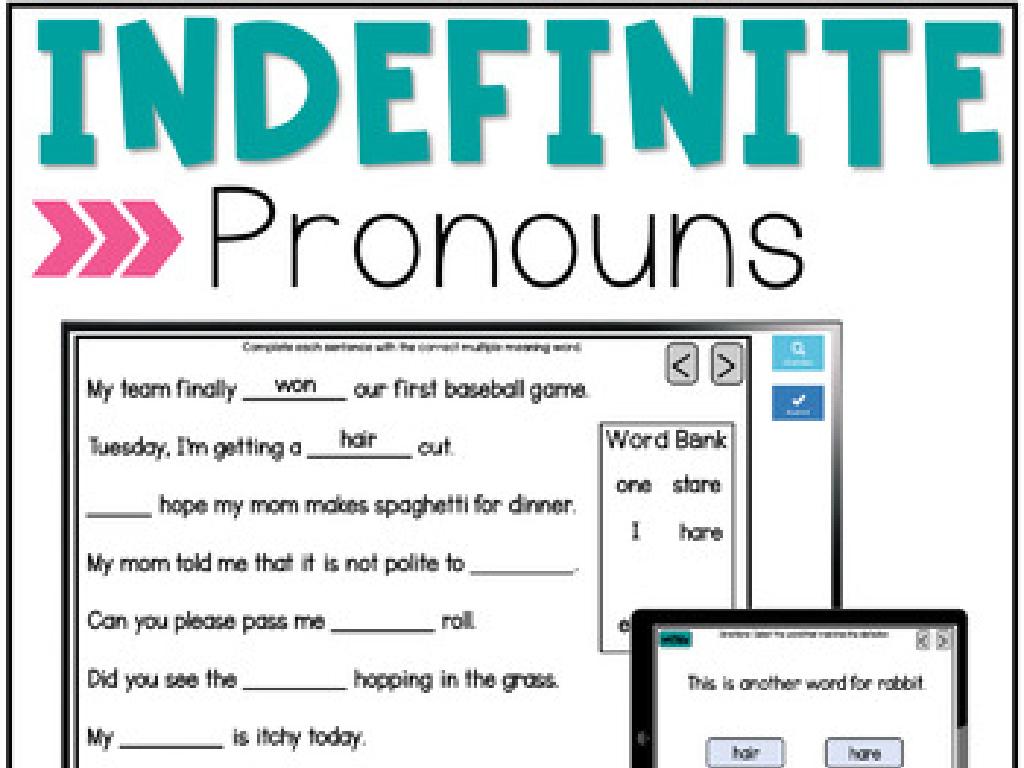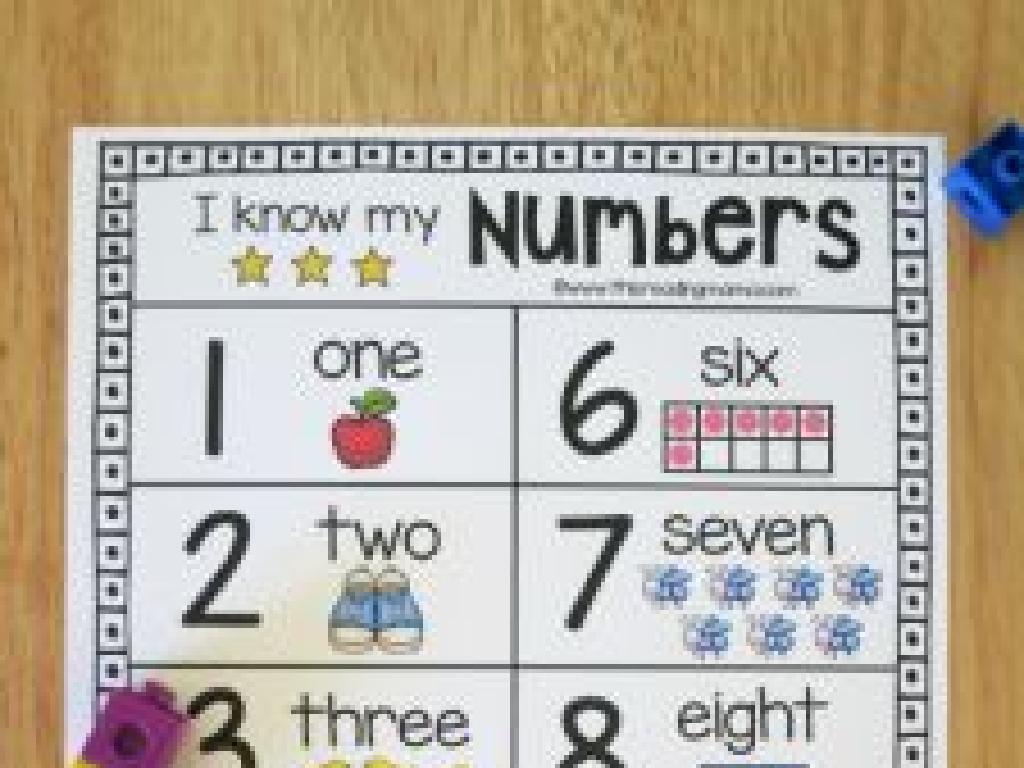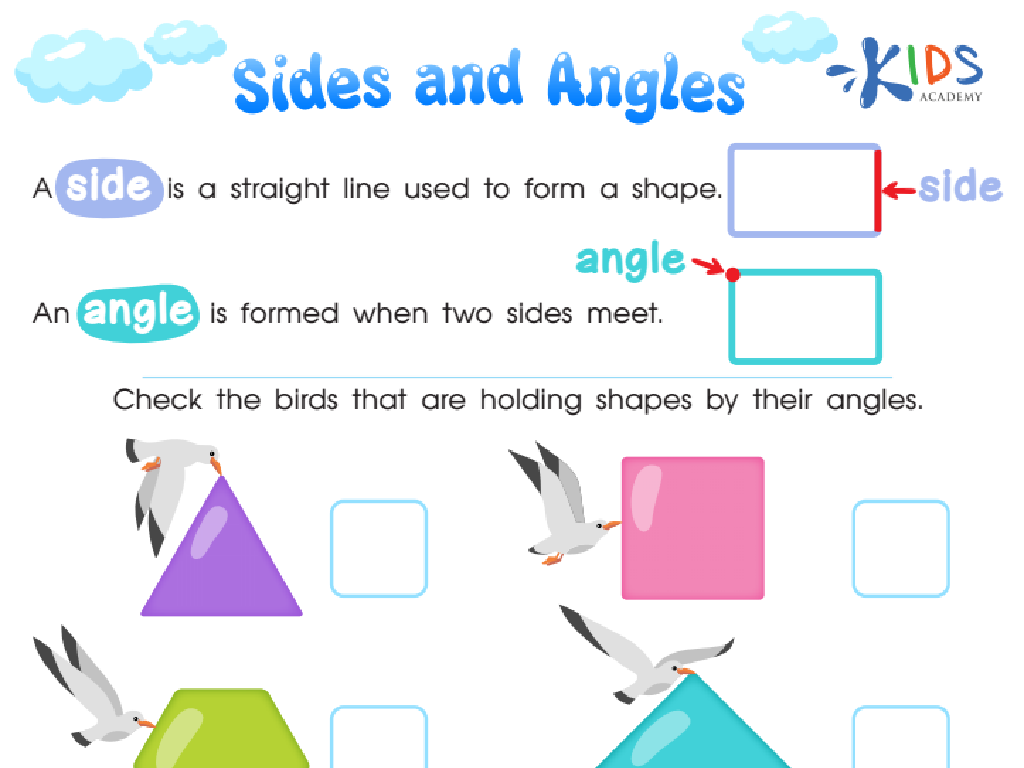Complete The Addition Sentence - Sums Up To 5
Subject: Math
Grade: Kindergarten
Topic: Addition Up To 5
Please LOG IN to download the presentation. Access is available to registered users only.
View More Content
Welcome to Addition!
– Greetings, little mathematicians!
– Today’s lesson: adding numbers
– We’ll learn how to combine numbers to make new ones.
– Practice sums that equal 5
– Find pairs of numbers that make 5 when added together.
– Fun with addition!
– We’ll use games and activities to enjoy learning addition.
|
This slide is designed to introduce Kindergarten students to the concept of addition, specifically focusing on sums that result in the number 5. Start the lesson with a warm and engaging greeting to capture the students’ attention. Explain that addition is the process of combining two or more numbers to make a new number. Use visual aids, such as fingers or counting objects, to demonstrate simple addition problems that result in the sum of 5. Incorporate interactive activities such as number pairing games to reinforce the concept. The goal is to create a fun and supportive environment where students can explore and understand the basics of addition.
Learning Addition: Sums Up to 5
– What is addition?
– Addition is combining numbers to see how many in total.
– Adding numbers up to 5
– We add numbers like 2 + 3 to make 5.
– Combining groups of items
– Imagine putting together two sets of toys.
– Practice with examples
– Let’s add 1 apple + 4 apples together!
|
This slide introduces the concept of addition to Kindergarten students by relating it to something familiar, like combining toys. Start by explaining that addition is simply putting together two or more numbers to find the total amount. Use visual aids like toy blocks or counters to demonstrate this concept. For example, show two blocks plus three blocks and count them all together to make five. Encourage the students to participate by asking them to combine groups of items they use daily, like crayons or snacks, to make a total of up to five. Provide simple addition problems and use real-life examples to help them practice and understand the concept of addition.
Learning Addition: Sums Up to 5
– Understanding the plus sign (+)
– The plus sign (+) tells us to put together two numbers.
– The equals sign (=) shows the total
– When we add, the equals sign (=) shows us the answer.
– Example: 2 + 3 equals 5
– See how 2 and 3 together make 5? That’s addition!
– Practice adding numbers to make 5
– Try with different numbers: 1+4, 0+5, what else?
|
This slide introduces the basic symbols used in addition for kindergarten students. Start by explaining the plus sign (+) as a way to combine two groups of items. Then, show how the equals sign (=) is used to indicate the result of this combination. Use visual aids like counting blocks or fingers to demonstrate the example 2 + 3 = 5. Encourage the students to practice with different combinations of numbers that add up to 5, using objects they can touch and count. This tactile approach helps solidify the concept of addition in their minds. Make sure to praise their efforts and correct gently, fostering a positive learning environment.
Let’s Add Up to 5!
– Adding numbers to make 5
– Example: 1 + 4 equals 5
– One plus four makes five
– Example: 2 + 3 equals 5
– Two plus three also makes five
– Think of other combinations for 5
– Can you find new ways to add to five?
|
This slide is aimed at helping Kindergarten students understand the concept of addition by combining different numbers to total up to 5. Start by explaining that addition is putting together numbers to make a new number. Show them the examples provided, using visual aids like fingers or counters if possible. Encourage the students to use objects or their fingers to find other combinations that add up to 5. This activity will help them grasp the concept of addition in a fun and interactive way. Make sure to praise their efforts and creativity as they come up with different combinations.
Your Turn to Add Up to 5!
– Let’s solve an addition problem
– Find the number that makes 5
– If we have 2, what plus 2 equals 5?
– Use your fingers to help count
– Hold up 2 fingers, then add more until you have 5 fingers up
– Share your answer with the class
– Tell us what number you added to 2 to get 5
|
This slide is an interactive activity for the students to practice addition with sums up to 5. Present an addition problem such as 2 + __ = 5 and encourage the students to find the missing number. Remind them to use their fingers if they need to count. This tactile method helps reinforce their understanding of addition. After they find the answer, ask them to share how they got to it. For variation, use different starting numbers and provide immediate positive feedback to keep the class engaged. Possible activities include using physical objects like blocks or counters, drawing pictures to represent the numbers, or playing a game where they ‘find’ the missing number around the classroom.
Complete the Addition Sentence
– Understand the missing piece
– Use fingers or objects to count
– Counting physically can help find the answer
– Example: 3 + __ = 5
– What number makes 5 when added to 3?
– Find the missing number
– The answer fills the blank to make the sentence true
|
This slide is aimed at helping Kindergarten students understand the concept of completing an addition sentence with sums up to 5. Start by explaining that a number sentence sometimes has a missing piece, which they need to find. Demonstrate how to use fingers or objects like blocks or beads to count up to the total sum. For example, if the sentence is 3 + __ = 5, they should start from 3 and count up two more to reach 5. Encourage students to practice with different examples and to use their fingers or classroom objects to find the missing number. This hands-on activity will help solidify their understanding of basic addition and the concept of ‘sums up to 5’.
Class Activity: Addition Bingo
– Let’s play Addition Bingo!
– Receive your own Bingo card
– Each card has different addition problems
– Cover spots summing up to 5
– Use counters to cover the correct answers
– Shout ‘Bingo!’ for a full row
|
This interactive activity is designed to help Kindergarten students practice addition with sums up to 5 in a fun and engaging way. Distribute unique Bingo cards to each student, ensuring that the addition problems are appropriate for their level. Provide them with counters or other small objects to cover the spots. As they solve the problems, they should look for sums that equal 5 and cover those spots. The goal is to reinforce their understanding of addition within 5 and to encourage quick mental calculations. Monitor the students as they play, offering help as needed. Celebrate the winners and encourage a positive learning environment where students cheer each other on. Possible variations of the activity could include team play, timed rounds, or larger Bingo cards for extended play.
Great Work on Addition Up to 5!
– Celebrate learning addition up to 5
– Encourage home practice
Try simple addition problems during playtime.
– Anticipate adding up to 10
Get ready for more fun with bigger numbers!
– Keep up the great work!
|
This slide is meant to congratulate the students on their progress with addition up to 5 and to encourage them to continue practicing at home. Reinforce the idea that practice is key to mastering new skills. Give examples of how they can incorporate addition into daily activities, like counting toys or snacks. Prepare them for the next lesson by mentioning that they will be learning to add numbers up to 10, building on what they’ve already mastered. The enthusiasm will set a positive tone for continued learning.






